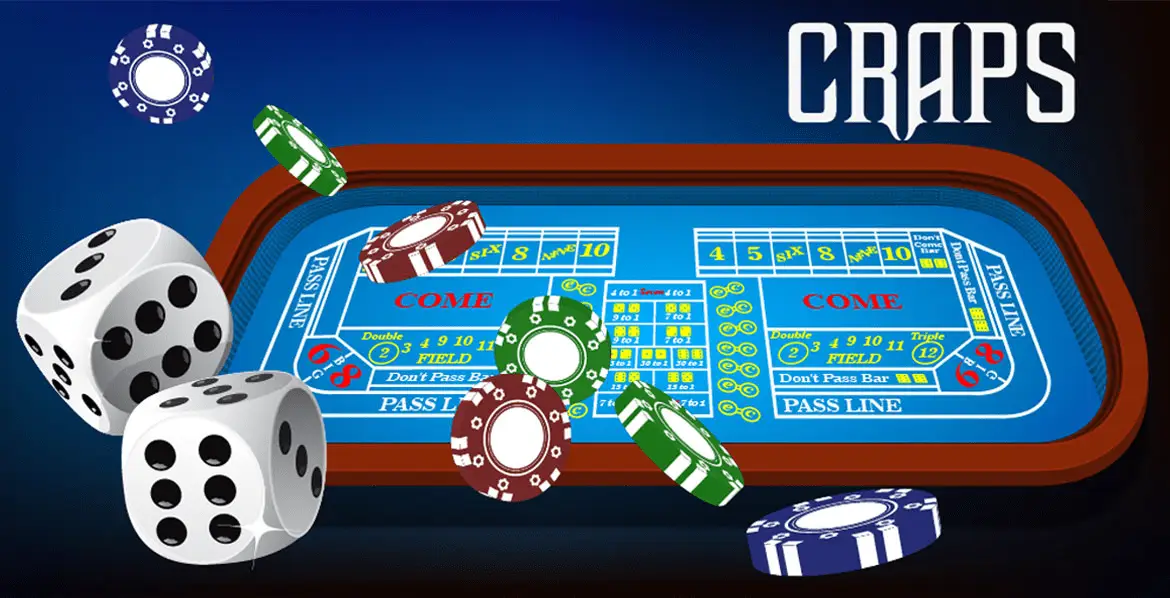Craps is an exciting world where dice rolls are combined with gambling strategies. Despite the apparent complexity due to the abundance of bets and terms, the entertainment is quite accessible to master. This article will be your guide to the types of craps bets and other aspects of the game in simple language.
Basic Craps Betting: Diving into the Basics
There are several types of bets in the game that allow you to manage your odds of winning. These decisions are the foundation on which the entire game is built, and understanding their mechanics is the first step towards success.

Pass Line: The Basics
Pass Line is one of the simplest and most popular bets that makes the game of craps so much fun. The decision is made before the dice are rolled, and it wins if the dice roll a 7 or 11. If the dice roll 2, 3 or 12, the bet loses. In other cases, a point is set, and to win, it must fall out again before the 7 appears. Pass Line is considered to be one of the safest, as the casino advantage here is minimal – only about 1.41%.
Don’t Pass Line: the opposite kind of Pass Line
Here the player makes the calculation that the combination of dice will not be in the shooter’s favour. The decision is won by rolling a 2 or 3 on the exit roll, and a 12 gives a tie (making the bet less favourable than Pass Line). If a point is established, the contestant needs a 7 to fall before the point falls again. The house’s percentage advantage here is slightly lower than Pass Line’s – around 1.36%.
Come and Don’t Come: risk selection
The Come bet is similar to Pass Line, but this type is applied after the point has been set in craps. In fact, it works like a new game within a game: the bet wins when a 7 or 11 is rolled and loses when a 2, 3 or 12 is rolled. If a point is set, Come wins when that point is rolled again.
Don’t Come works similarly to Don’t Pass Line, but is made after the point is set. Here, the player wins if a 2 or 3 comes up and a 12 results in a draw.
Types of risky bets in craps: when the player is ready for maximum payouts and risks
 Beyond the basic calculations, there are risky choices that give players a chance at big wins. Let’s take a look at the variations that often attract attention thanks to big payouts.
Beyond the basic calculations, there are risky choices that give players a chance at big wins. Let’s take a look at the variations that often attract attention thanks to big payouts.
Field
Field is a kind of “here and now” bet. It is applied on a single roll and wins if 2, 3, 4, 9, 10, 11 or 12 are rolled. It is important to note that the payout depends on the result: if there is a 2 or 12 on the table, the bet brings double or even triple the winnings. The probability of winning is only 44.4%, which makes the decision risky, although it is quite popular among beginners due to the instant results.
Hardways
The expectation is that a certain pair, such as two fours (to get an 8), will be rolled. This bet wins if the selected pair is rolled and loses if any other combination that gives the same number or 7 is rolled. The probability of winning is low, but the payout is generous – depending on the number, it can be 7 to 1 or even 9 to 1.
Any 7
The player bets that the next roll will result in a 7. This is one of the riskiest bets, as the probability of winning is only 16.67%. But the payout is quite attractive – 4 to 1. Despite the high risk, many participants make this bet, hoping for a quick win. Nevertheless, this is not the most recommended strategy for beginners due to the high casino advantage of about 16.9%.
Craps betting strategies: how to increase your chances of winning
In order to minimise risk and increase your chances of winning, it is important to employ specific tactics to help you manage your actions at the table. Here are a few popular strategies suitable for beginners and experienced players alike.
Martingale: increase the bet after a loss
The strategy consists in doubling the bet after each loss in order to compensate all previous losses and get a small profit at the next win. For example, if you bet $5 and lost, the next amount should be $10. If you are unlucky again – 20, and so on until you win. Despite its simplicity, this system carries serious risks, especially if the bankroll is limited – you can easily find yourself in a situation where you simply do not have enough money for the next decisions.
Pass Line to minimise risk
For beginners, Pass Line betting remains the best choice in craps as it provides a low casino advantage and gives the player a good chance of winning. By using it in combination with additional Odds bets, players can minimise the impact of the house advantage. This strategy allows you to confidently participate in the game without exposing yourself to excessive risks.
Combination bets for maximum profit
This is a way to make the game more varied and increase your chances of winning. For example, you can use Pass Line in conjunction with Come, which allows you to control multiple points simultaneously. This approach helps to minimise losses and increases the chances of winning, especially if the dice roll is in the player’s favour.
Summary and Recommendations
 Studying the types of craps bets helps to understand which ones are best for beginners and which ones require more experience and training. For beginners, Pass Line and Come are recommended, as they offer a good chance of success with a minimal casino advantage. Those who want to try their hand with riskier bets should consider the high risk and calculate their bankroll carefully, so as not to find themselves in a situation where decisions become too expensive.
Studying the types of craps bets helps to understand which ones are best for beginners and which ones require more experience and training. For beginners, Pass Line and Come are recommended, as they offer a good chance of success with a minimal casino advantage. Those who want to try their hand with riskier bets should consider the high risk and calculate their bankroll carefully, so as not to find themselves in a situation where decisions become too expensive.

To become a successful player, it is important not only to know how to bet, but also to apply strategies that will help increase your chances of success. Use the knowledge you have gained, practice different combinations and don’t forget to enjoy the process – after all, craps is first and foremost a game that gives emotions and drive!
 en
en  de
de  ar
ar  es
es  hi
hi  fr
fr  nl
nl  ru
ru  it
it  pt
pt  el
el 










